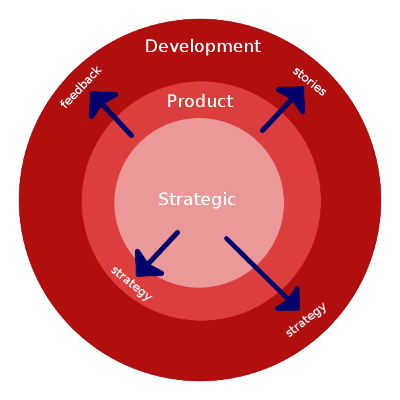
Although not a hard-and-fast rule, I see the tiers of an agile organisation being the following:
- Strategic tier
- Product tier
- Development tier
Strategic tier
The strategic tier is responsible for deciding the long-term goals, such as:
- What new products should be developed
- What products should be retired
- What markets are the products aimed at (for example, moving a product in to a new country)
- What should the product-set look like in the future (1, 3, 5 years from now)
- What cross-product work should be done and how it should be prioritised against individual product work
Product tier
The product tier is tasked with taking the strategic goals and translating them in to a product development roadmap. They are concerned with details, formulating themes and epic ideas plus breaking them down in to individual user journeys.
Development tier
The development tier is concerned with delivery of the changes driven by the product tier. Their primary responsibility is to deliver on the prioritised work list but their secondary goal is self-improvement, i.e. making the delivery process more effective.
In most companies I would say that the strategic tier is represented by the executive. The product tier is represented by the Product Owner, although there is usually a much wider stakeholder engagement. The development tier is represented by the development teams themselves.
Mixing the tiers
From what I have read there are organisations that have successfully blurred the lines between these tiers. For example by having the development teams engaged in proposing product features.
There is no hard and fast rule for the tiers of an agile organisation. In some companies the strategic tier does not exist and the product tier does both strategic and tactical product work. I can see how this can work and would not object to it. However I can also see how there is value in using the tiers as a form of specialisation, introducing clear boundaries (or gates) between them. For example, the product team only passes work to the development tier if it has been prioritised and comes through a Product Owner.